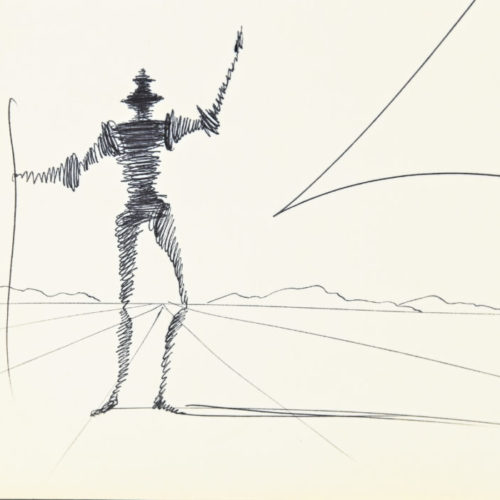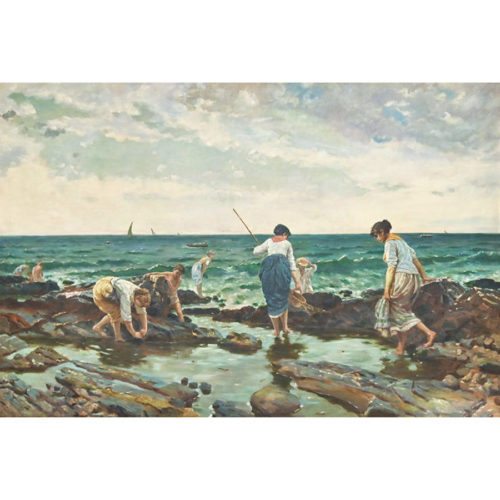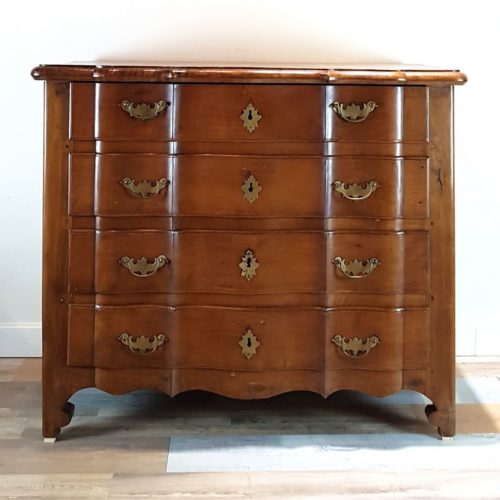"Dali - De Draeger" catalogue by Max Gérard, 1968.
The catalogue has a drawing of Don Quixote, with a dedication on the guard paper, a gift from the Catalan artist Salvador Dali (Figueras 1904 - 1989)
"Every morning, as I wake up, I experience a supreme pleasure that I am discovering today for the first time: that of being Salvador Dali, and I wonder, filled with wonder, what this Salvador Dali will do again today that is so prodigious. And every day it is more difficult for me to understand how others can live without being Gala or Salvador Dali.
A Catalan with a thirst for gold and glory, Dali painted a lot and talked a lot. His favourite subject: how to become a genius. His conclusion: 'Oh, Salvador, now you know, if you play at being a genius, you will become one!
Salvador Dali's taste for provocation, excessive character, pursuit of paradox and exaggerated egocentricity have made him a well-known figure to the general public. These elements have helped to turn a great artist - endowed with a fervid creative intelligence and a profound knowledge of the history of the arts, the masters of the past and the literary research of his time - into a myth, which still arouses great curiosity today.
However, his continuous exposure as an absolute 'genius' of art, to critics and to the judgement of the public, has given the impression of being able to fully understand his work and easily enter into his thought. In reality, his entire oeuvre reveals a very complex personality.
Like his compatriot Picasso, Dali experimented with different expressive languages during his long career, moving away from painting towards cinema, theatre, photography and even performance.
"At the age of six I wanted to be a cook. At seven I wanted to be Napoleon. And my ambition has been steadily growing ever since".
Dali's life and work are inextricably intertwined, in fact many events in the artist's life were reflected in his creations, and many paintings can only be understood on the basis of the events that marked his life.
At the age of six he painted his first canvas. Then, at the age of ten, he received his first drawing lesson, under the guidance of the famous Impressionist painter Ramón Pichot (1872 - 1925). He would later say that he was influenced by Pichot's works, which represented his first contact with a non-academic artistic current, focused on the reality of his time. At the age of fourteen he discovered the pompiers, at twenty-two cubism and at twenty-four he was already Dali, convinced that he had been called Salvador because he was destined to be the "saviour" of painting threatened with death by abstract art, academic surrealism, Dadaism in general and all the anarchic isms. At the age of 25, he was already winning over critics, doing business with gallery owners and collecting scandals.
Period: 1968
Measurements: Page size with drawing and dedication H 30 x W 27.5 cm
 "Dali - De Draeger" catalogue by Max Gérard, 1968. The catalogue has a drawing of Don Quixote, with a dedication on the guard paper, a gift from the Catalan artist Salvador Dali (Figueras 1904 - 1989) "Every morning, as I wake up, I experience a supreme pleasure that I am discovering today for the first time: that of being Salvador Dali, and I wonder, filled with wonder, what this Salvador Dali will do again today that is so prodigious. And every day it is more difficult for me to understand how others can live without being Gala or Salvador Dali. A Catalan with a thirst for gold and glory, Dali painted a lot and talked a lot. His favourite subject: how to become a genius. His conclusion: 'Oh, Salvador, now you know, if you play at being a genius, you will become one! Salvador Dali's taste for provocation, excessive character, pursuit of paradox and exaggerated egocentricity have made him a well-known figure to the general public. These elements have helped to turn a great artist - endowed with a fervid creative intelligence and a profound knowledge of the history of the arts, the masters of the past and the literary research of his time - into a myth, which still arouses great curiosity today. However, his continuous exposure as an absolute 'genius' of art, to critics and to the judgement of the public, has given the impression of being able to fully understand his work and easily enter into his thought. In reality, his entire oeuvre reveals a very complex personality. Like his compatriot Picasso, Dali experimented with different expressive languages during his long career, moving away from painting towards cinema, theatre, photography and even performance. "At the age of six I wanted to be a cook. At seven I wanted to be Napoleon. And my ambition has been steadily growing ever since". Dali's life and work are inextricably intertwined, in fact many events in the artist's life were reflected in his creations, and many paintings can only be understood on the basis of the events that marked his life. At the age of six he painted his first canvas. Then, at the age of ten, he received his first drawing lesson, under the guidance of the famous Impressionist painter Ramón Pichot (1872 - 1925). He would later say that he was influenced by Pichot's works, which represented his first contact with a non-academic artistic current, focused on the reality of his time. At the age of fourteen he discovered the pompiers, at twenty-two cubism and at twenty-four he was already Dali, convinced that he had been called Salvador because he was destined to be the "saviour" of painting threatened with death by abstract art, academic surrealism, Dadaism in general and all the anarchic isms. At the age of 25, he was already winning over critics, doing business with gallery owners and collecting scandals. Period: 1968 Measurements: Page size with drawing and dedication H 30 x W 27.5 cm
"Dali - De Draeger" catalogue by Max Gérard, 1968. The catalogue has a drawing of Don Quixote, with a dedication on the guard paper, a gift from the Catalan artist Salvador Dali (Figueras 1904 - 1989) "Every morning, as I wake up, I experience a supreme pleasure that I am discovering today for the first time: that of being Salvador Dali, and I wonder, filled with wonder, what this Salvador Dali will do again today that is so prodigious. And every day it is more difficult for me to understand how others can live without being Gala or Salvador Dali. A Catalan with a thirst for gold and glory, Dali painted a lot and talked a lot. His favourite subject: how to become a genius. His conclusion: 'Oh, Salvador, now you know, if you play at being a genius, you will become one! Salvador Dali's taste for provocation, excessive character, pursuit of paradox and exaggerated egocentricity have made him a well-known figure to the general public. These elements have helped to turn a great artist - endowed with a fervid creative intelligence and a profound knowledge of the history of the arts, the masters of the past and the literary research of his time - into a myth, which still arouses great curiosity today. However, his continuous exposure as an absolute 'genius' of art, to critics and to the judgement of the public, has given the impression of being able to fully understand his work and easily enter into his thought. In reality, his entire oeuvre reveals a very complex personality. Like his compatriot Picasso, Dali experimented with different expressive languages during his long career, moving away from painting towards cinema, theatre, photography and even performance. "At the age of six I wanted to be a cook. At seven I wanted to be Napoleon. And my ambition has been steadily growing ever since". Dali's life and work are inextricably intertwined, in fact many events in the artist's life were reflected in his creations, and many paintings can only be understood on the basis of the events that marked his life. At the age of six he painted his first canvas. Then, at the age of ten, he received his first drawing lesson, under the guidance of the famous Impressionist painter Ramón Pichot (1872 - 1925). He would later say that he was influenced by Pichot's works, which represented his first contact with a non-academic artistic current, focused on the reality of his time. At the age of fourteen he discovered the pompiers, at twenty-two cubism and at twenty-four he was already Dali, convinced that he had been called Salvador because he was destined to be the "saviour" of painting threatened with death by abstract art, academic surrealism, Dadaism in general and all the anarchic isms. At the age of 25, he was already winning over critics, doing business with gallery owners and collecting scandals. Period: 1968 Measurements: Page size with drawing and dedication H 30 x W 27.5 cm Large Louis Philippe mirror in carved wood and gilded with gold leaf, dating back to 1880, original mirror, excellent condition Period: Second half of the 19th century Measurements: H 180 x W 97 x D 5 cm
Large Louis Philippe mirror in carved wood and gilded with gold leaf, dating back to 1880, original mirror, excellent condition Period: Second half of the 19th century Measurements: H 180 x W 97 x D 5 cm
